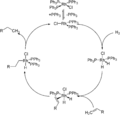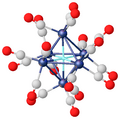Hydride facts for kids
A hydride is a special kind of chemical compound. It's made when hydrogen atoms join with atoms of other elements. Almost every element on the periodic table can form a hydride, except for a few Noble gases. Hydrides can be very different from each other, but some share similar features.
Contents
Different Kinds of Hydrides
Ionic Hydrides
These hydrides are formed when hydrogen bonds with very reactive metals, like those in the alkali metal and alkaline earth metal groups (think sodium or calcium). They have a strong type of bond called an ionic bond. This means one atom gives electrons to another. Ionic hydrides are very reactive and don't easily dissolve in liquids.
Metallic Hydrides
Metallic hydrides are also known as interstitial hydrides. They keep many properties of metals, such as being good at carrying electricity and heat. They are called "interstitial" because hydrogen atoms can fit into the tiny spaces within the metal's structure. Most metallic hydrides are made from metals in groups 3 to 5 of the periodic table. Some of these hydrides are used in important technologies, like the nickel-metal hydride battery found in many rechargeable devices.
Covalent Hydrides
Covalent hydrides have a different type of bond called a covalent bond. This means the hydrogen atoms share electrons with the other element. Many elements from the p-block of the periodic table form covalent hydrides. These hydrides can sometimes be unstable, meaning they might react easily with air or water, or break down when heated. Common examples you might know are hydrocarbons (which are hydrides of carbon, like methane), ammonia (a hydride of nitrogen), and even water (a hydride of oxygen).
Images for kids
See also
 In Spanish: Hidruro para niños
In Spanish: Hidruro para niños





